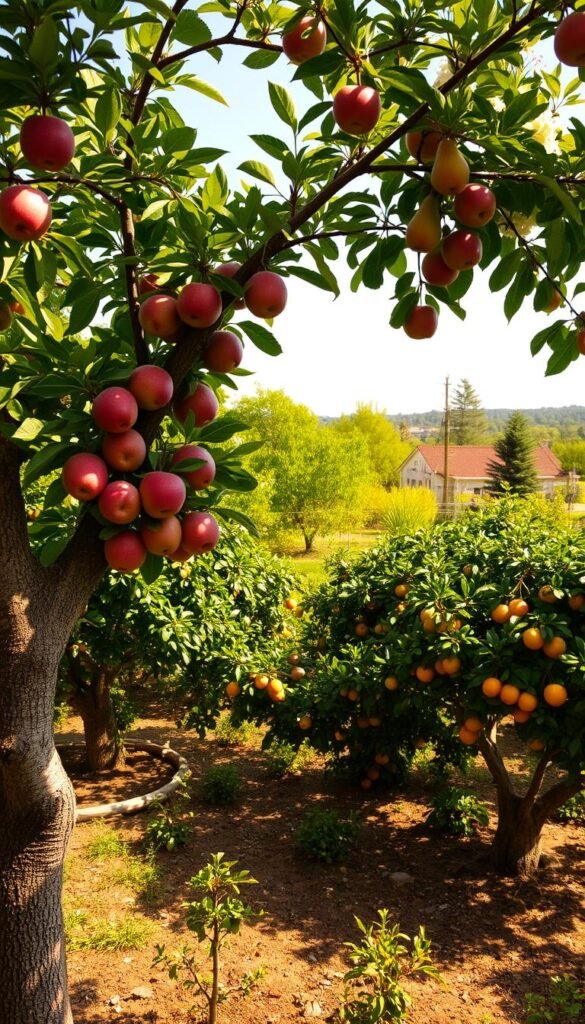Imagine stepping outside to pick sun-warmed treats from your own backyard. Trees offering juicy rewards year after year aren’t just for farmers—they’re perfect for time-strapped enthusiasts craving fresh flavors without daily fuss. Unlike veggies needing constant care, these natural producers thrive with minimal effort once established.
Your options stretch far beyond typical apples and pears. From tangy citrus to tropical mangoes, modern breeding brings exciting possibilities to ordinary spaces. But here’s the catch: what flourishes in Texas might freeze solid in Minnesota. Matching plants to your weather patterns makes all the difference between thriving groves and heartbreak.
City dwellers face unique challenges compared to rural growers. Limited square footage calls for compact cultivars and creative solutions like espalier training. Forget tractor-sized equipment—you’ll learn space-smart techniques that deliver satisfying yields without farm-scale commitments.
This guide walks you through climate-smart selections and urban-growing hacks. You’ll discover how to bypass common pitfalls and set up a low-maintenance edible paradise tailored to your local conditions. Let’s dig into the secrets of choosing plants that actually enjoy living in your neighborhood.
Understanding Your Climate and Garden Environment
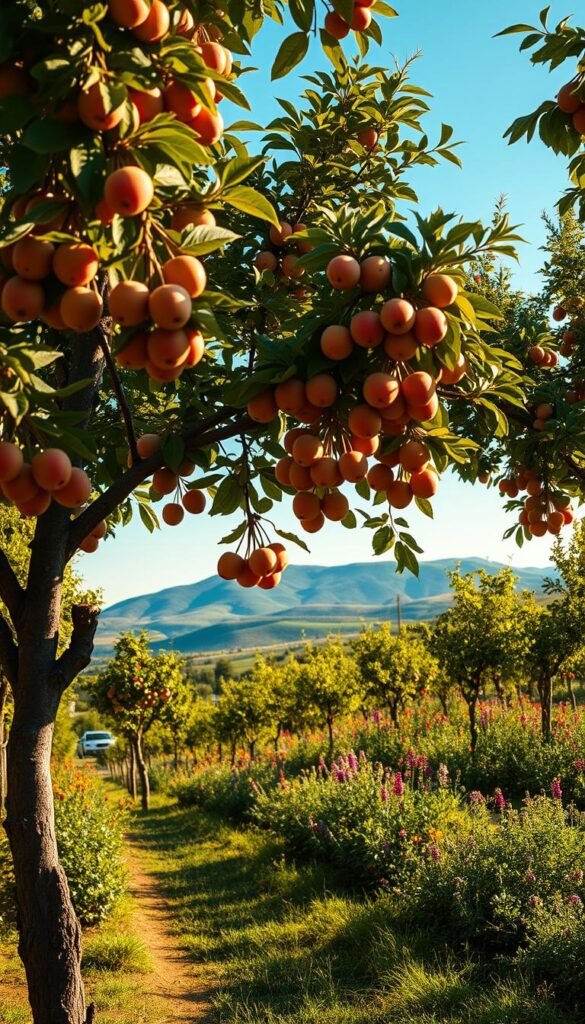
Your location’s unique fingerprint—its cold snaps, heat waves, and seasonal shifts—determines which plants will flourish. Start by decoding your USDA hardiness zone, a number that reveals your area’s average minimum winter temperatures. This simple code (findable via the USDA website) acts like a cheat sheet for choosing trees built to survive your coldest nights.
Chill Hours: Nature’s Reset Button
Many trees need winter downtime to bear summer rewards. Chill hours—those 32-46°F periods from October to February—tell apples, peaches, and pears when to wake up. Phoenix residents (350 average hours) should pick low-chill options like ‘Anna’ apples, while Minnesotans can enjoy high-demand varieties. Always check nursery tags: unlabeled trees might leave you fruitless.
Local Weather Surprises
Your microclimate holds hidden quirks. Coastal fog? Late frosts? Track your area’s typical patterns through extension offices or gardening apps. A plum tree thriving in Texas might sulk in Oregon’s humidity. Watch for spring heat spikes that trick buds into blooming too early, only to get zapped by a final freeze.
Pro tip: Cross-reference your zone and average chill hours before buying. This duo eliminates guesswork and sets your edible oasis up for decades of productivity.
Fruit Garden Basics: Selecting the Right Varieties for Your Climate
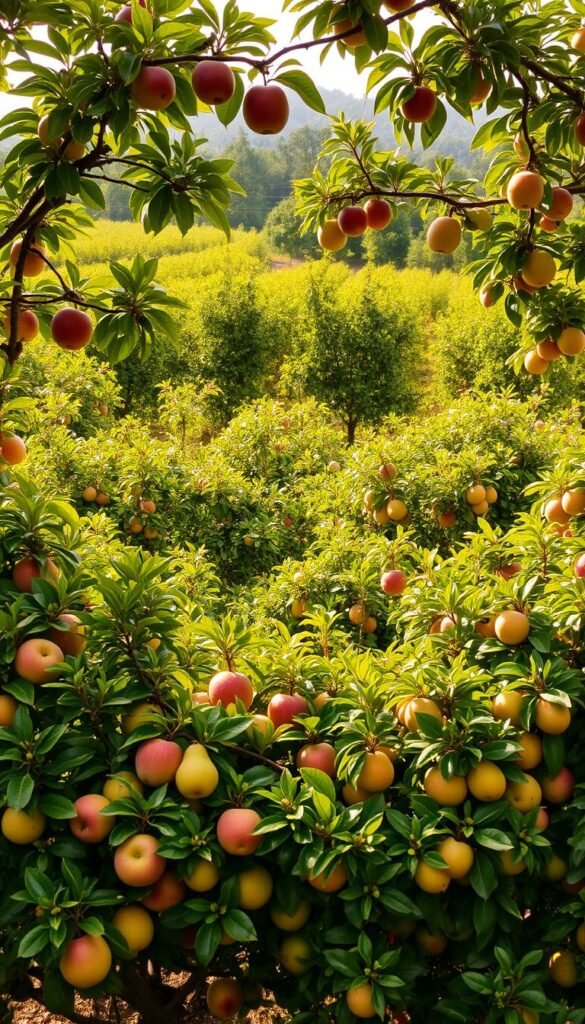
Not every star performer at the grocery store thrives in backyard soil. Some crave specific weather patterns that your area might not offer. Let’s explore how to match botanical personalities to your location’s quirks.
Local Champions vs. Tempting Newcomers
Honeycrisp apples dazzle in Minnesota’s chill but crack under desert heat. For arid zones, Gala apples deliver similar crunch without the drama. Santa Rosa plums show why they’ve been backyard favorites since 1906—these self-pollinators adapt from coastal fog to southern humidity.
Specialty hybrids like Flavor King pluots demand precise conditions. If apricots struggle in your soil, swap them for Methley plums. These juicy alternatives handle clay soils and variable rainfall better than their finicky cousins.
Stagger Your Sweetness
Extend your harvest window with strategic pairing:
- Peaches: Combine ‘Early Redhaven’ (July), ‘Redskin’ (August), and ‘Frost’ (September)
- Apples: Mix ‘Lodi’ (summer), ‘Honeycrisp’ (fall), and ‘Arkansas Black’ (late fall)
- Plums: Plant ‘Methley’ (early) with ‘Shiro’ (mid-season) for 8-week yields
This approach keeps your kitchen stocked without overwhelming you with simultaneous ripening. Nurseries often tag plants with bloom times—use these codes to build your custom calendar.
Evaluating Yard Space and Soil Conditions
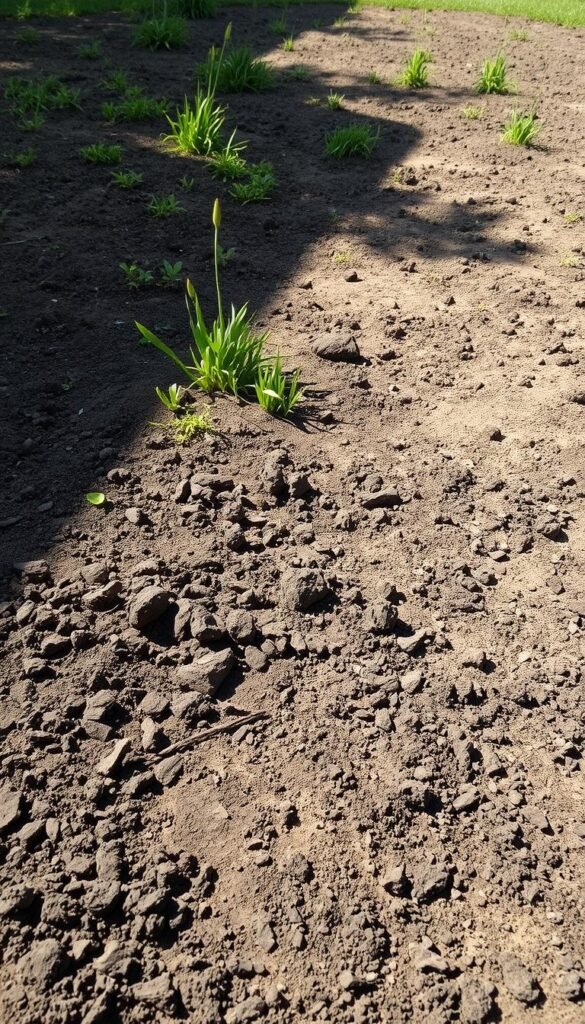
Your backyard’s layout holds secrets that determine whether trees thrive or barely survive. Start by mapping where sunlight lingers longest—most edible plants demand six hours of direct rays. Watch how shadows move across your yard through seasons, noting spots that stay shaded past noon.
Sunlight and Drainage Essentials
Low-lying areas become death traps when rain pools around roots. Test drainage by digging a 12-inch hole: if water remains after 24 hours, build mounds or raised beds. A 3×3-foot box filled with sandy loam gives roots breathing room they crave.
Wind patterns matter more than you think. Plant tall varieties on the north side to shield others, but leave 8-10 feet between trunks and structures. Tight spacing starves roots and blocks airflow—prime conditions for mold and pests.
For stubborn clay soil, mix in compost annually to improve texture. Remember: winter waterlogging kills more trees than summer droughts. Smart placement today means fewer headaches tomorrow.
Planting Techniques and Urban Orchard Culture
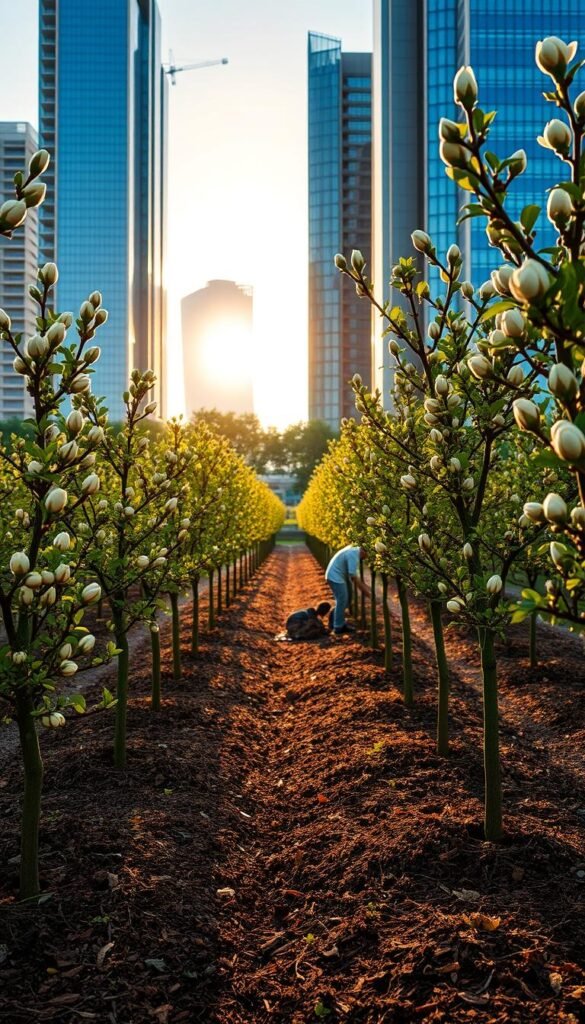
City spaces bloom with edible potential when you rethink traditional growing methods. Modern approaches let you pack surprising variety into tight quarters while maintaining healthy, productive plants.
Preparing Planting Holes and Raised Bed Solutions
Dig smarter, not harder. For container-grown trees, make holes exactly as deep as the root ball—usually 12 inches. Widen them to three times the root spread, shaping sides like a shallow cone. This gives new roots room to stretch without sinking too deep.
Place your tree in the center, then backfill with native soil. Firmly tamp down to remove air pockets—roots need solid contact to drink properly. Skip soil amendments unless dealing with extreme sand or clay. As one nursery pro notes: “Nature prefers local dirt—it helps plants adapt faster.”
Embracing High-Density Planting Methods
Think vertical, not horizontal. Keep trees at 6-8 feet tall through summer pruning. This lets you plant 12 varieties where one giant specimen once grew. Space them 6 feet apart to form productive privacy screens that drip with peaches or plums.
Containers offer flexibility for patios and balconies. Choose dwarf varieties in 15-gallon pots with drainage holes. Bareroot options work too—plant them dormant between January and June for best results. Either method delivers fresh snacks steps from your kitchen.
Watering and Irrigation Essentials for Fruit Trees
Hydration habits make or break your edible investments. Young saplings need attentive care during their first year—keep soil damp like a wrung-out sponge, not soggy. This critical period builds drought resilience for future seasons.
Developing a regular watering routine
Deep soaking every 10 days beats daily sprinkles. Saturate soil 18 inches down to encourage roots to chase moisture. Watch for curled leaves (thirsty) or yellowing (drowning). Adjust frequency during summer heat waves—container plants may need twice-weekly drinks.
Smart gardeners automate hydration. Drip systems with adjustable emitters deliver precise amounts year-round. Set timers for early morning to reduce evaporation. Citrus varieties demand special attention—their roots rot faster in wet clay than apple or pear trees.
Track rainfall with a simple gauge. Skip watering after 1-inch storms. As plants mature, stretch intervals to 14 days. By year three, most established trees only need help during extreme dry spells. Your patience now means less work later.
Pruning, Maintenance, and Tree Care Strategies

Healthy trees start with smart care habits that evolve through the seasons. While newly planted specimens need gentle handling, mature plants demand strategic cuts and nutrient boosts. Let’s explore how to keep your leafy investments thriving through their first fragile years and beyond.
Smart Timing for Strategic Shaping
Resist pruning new trees during their debut year—let roots strengthen first. Come late winter, grab those shears when plants are dormant but frost risks fade. Target dead branches and inward-growing limbs first, creating that coveted open-center shape.
Summer trims control size without sacrificing yields. Snip vigorous vertical shoots by one-third after harvest. This redirects energy to growing fruit instead of excessive foliage. Remember: Never remove more than 25% of canopy in a single season.
Feeding and Protecting Your Investment
Spread nutrients wisely each spring. Broadcast granular fertilizer at the drip line—where rain naturally washes food to roots. Citrus demands extra iron and zinc; other types thrive with balanced 10-10-10 blends.
Prevent problems before they start. Dormant oil sprays smother overwintering pests on trunk and branches. Copper fungicide applied after pruning seals cuts against disease. Refresh mulch annually to retain moisture and suppress weeds, keeping it 6 inches from the trunk.
Maximizing Harvest with Successive Ripening
Transform your harvest calendar from a sprint to a marathon with clever variety selection. Instead of facing a crop tsunami, enjoy steady pickings that match your kitchen’s capacity. This method works wonders for busy households craving fresh flavors without preservation marathons.
Staggered Sweetness in Action
Phoenix growers stretch peach season from May to July using three varieties:
- Desert Gold (mid-May)
- Tropic Snow (early June)
- Mid Pride (late June)
This trio turns a typical 3-week bonanza into 12 weeks of manageable picking. Smaller trees mean easier maintenance—no ladders needed for that perfect harvest.
Apples and plums follow similar rules. Pair early bloomers like ‘Lodi’ with late stars like ‘Arkansas Black’ for applesauce-making from July through October. The secret? Nurseries now tag plants with bloom times—use these codes to design your personal season.
Multiple modest yields beat single overwhelming hauls. You’ll reduce waste while enjoying tree-ripe quality. Bonus: staggered crops handle unexpected frosts better—if one variety gets nipped, others often escape unscathed.
Final Reflections on Your Fruit Garden Journey
You’ve now got the tools to turn your outdoor space into a thriving edible retreat. Matching plants to your climate’s chill hours and soil type sets the stage for success. Remember: citrus loves warmth, while pears handle cooler zones with ease.
Containers offer flexibility if your yard has limited space. Dwarf varieties like ‘Dwarf Meyer Lemon’ thrive in pots, delivering fresh flavors without demanding acres. Always check local climate patterns before choosing—what works in Florida might fail in Colorado.
Timing matters as much as location. For precise scheduling based on your area’s temperatures, explore our guide to perfect planting schedules. Proper nutrients and spring pruning keep trees productive for decades.
Your patience pays off. Those first few years of care lead to baskets of plums, crisp apples, and juicy harvests. Now’s the time to plant—your future self will thank you for every sun-ripened bite.

